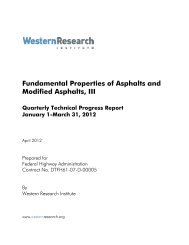Fundamental Properties of Asphalts and Modified Asphalts, III
Fundamental Properties of Asphalts and Modified Asphalts, III
Fundamental Properties of Asphalts and Modified Asphalts, III
You also want an ePaper? Increase the reach of your titles
YUMPU automatically turns print PDFs into web optimized ePapers that Google loves.
to crack initiation brought on by fatigue, followed by pavement failure, as a function <strong>of</strong><br />
environmental conditions <strong>and</strong> loading cycles?<br />
It has also been hypothesized that the process <strong>of</strong> combining asphalt with aggregate at high<br />
temperatures, placing this composite material in a roadway, <strong>and</strong> then allowing it to cool <strong>and</strong> cure<br />
may be modeled as a solidification process. Solidification processes are generally considered to<br />
be non-equilibrium thermodynamic processes where fluxes in composition <strong>and</strong> thermal gradients<br />
are driven by both mechanical <strong>and</strong> thermodynamic forces (e.g., chemical potential, surface<br />
tension <strong>and</strong> pressure differentials), thereby constituting mechanisms for order-disorder<br />
transitions that result in the formation <strong>of</strong> microstructural grain boundaries. These order-disorder<br />
transitions could also be responsible for cohesive failures when, for example, subjected to<br />
temperature fluctuations, shear <strong>and</strong> compressive loading, <strong>and</strong> exposure to moisture. Thus, a<br />
thorough investigation <strong>of</strong> the “chemical-action” <strong>of</strong> asphalt binder as it exists in pavements is<br />
warranted in order to define the interfacial boundary conditions <strong>and</strong> kinetic driving mechanisms<br />
that describe the formation <strong>and</strong> destruction <strong>of</strong> microstructural phases in asphalt when adopted by<br />
continuum mechanical modeling approaches used to simulate fatigue damage.<br />
Background<br />
In this subtask a somewhat simplified view has been taken to describe the composition <strong>of</strong> asphalt<br />
thin-films in a “pavement structure.” This is particularly true at the mastic level, which may be<br />
viewed as if one were building s<strong>and</strong>castles with asphalt in place <strong>of</strong> water as the binding agent to<br />
adhere <strong>and</strong> maintain structural form to the system. While constructing such a system, many<br />
different forces can be considered that could contribute to the strength <strong>of</strong> the system. These<br />
forces may include the capillarity <strong>and</strong> adhesion between asphalt <strong>and</strong> aggregate fine particles, the<br />
viscoelastic response <strong>of</strong> the asphalt thin-films between aggregate particles to compression <strong>and</strong><br />
shear forces, <strong>and</strong> breakdown <strong>of</strong> both the cohesive strength <strong>of</strong> the asphalt <strong>and</strong> the adhesive bonds<br />
between asphalt <strong>and</strong> aggregate in the presence <strong>of</strong> moisture. For the sake <strong>of</strong> the present<br />
discussion, figure 2-3.1 depicts a volume element slice <strong>of</strong> an 8-μm thick asphalt thin-film<br />
adhering three aggregate fine particles together in a mastic sub-structure <strong>of</strong> a pavement structure.<br />
If the presence <strong>of</strong> the aggregate particles in this system have an influence on the ordering <strong>of</strong> the<br />
asphalt molecules at the interface (e.g., first monolayer, first 200-nm, first 1.0-μm, etc) at what<br />
distance away from this interface would long-range molecular ordering subside? At what<br />
effective distance away from this interface would the asphalt layer have properties similar to a<br />
bulk phase state? In the present scenario, asphalt “molecules” present at the interface would<br />
experience the strongest interactions with the aggregate surface. Four microns out into the film,<br />
approximately halfway between two <strong>of</strong> these particles, the asphalt should exhibit properties more<br />
closely resembling that <strong>of</strong> asphalt in the “bulk” state.<br />
Based on AFM surface imaging it has been observed that thicker thin-films <strong>of</strong> asphalt (>4.0 μm)<br />
do not differ that much in appearance from films that are 10’s <strong>of</strong> microns or even 1.0-mm in<br />
thickness. As these films are decreased to





